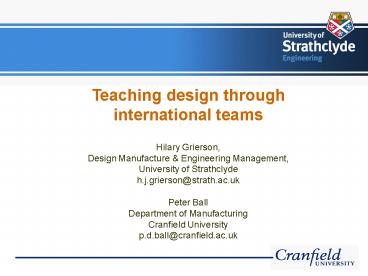Teaching design through international teams - PowerPoint PPT Presentation
1 / 19
Title:
Teaching design through international teams
Description:
Hilary Grierson Design Manufacture & Engineering Management Peter Ball ... Different cultures and approaches to work, formality/informality ... – PowerPoint PPT presentation
Number of Views:94
Avg rating:3.0/5.0
Title: Teaching design through international teams
1
(No Transcript)
2
Teaching design through international teams
- Why do it?
- Case study 1 Operations Management
- Overview
- Teaching module that emerged
- Closing remarks
- Case study 2 Global Design
- Overview
- Findings
- Closing remarks
- Summary
3
Why do it?
- To reflect how operations management and design
is carried out in practice - To broaden student experience
- To learn from others
4
Two case studies
- Operations management (Peter)
- Penultimate honours year students
- With Iowa State University, USA
- Haggis production and sales
- learning on behaviour
- Global design (Hilary)
- Undergraduate 5th year students (some from ops
mgt!) - With Stanford University and Olin College, USA
- Design of coffee cup holder
- learning on nature management of distributed
design
5
What is haggis?
6
Operations management global teams
- To understand practice of operations management
- Sharing, working across time zones, rarely
meeting, etc. - Collaborators
- Iowa State ( Mexico China)
- Initiated by Iowa State to introduce global
teaching - Teaching in parallel
- Students independently taught
- Collaboration on assignment
- 30 teams of 4 students
- 6 weeks student activity (3 weeks intense)
- 25 of module (12 modules/year)
- Resources
- Problem Solving Learning Portal
- Case data (reasonably complete!)
7
The model that emerged
BALL, P.D., GRIERSON, H., MIN, J., JACKMAN, J.K.
PATTERSON, P. Working on an assignment with
people you'll never meet! Case study on learning
operations management in international teams,
International Journal of Engineering Education,
Vol. 23, No. 2.
8
Case study 1 closing remarks
- Students
- Initially exciting
- Hard work managing
- Rewarding outcome
- Staff
- Fun
- Time consuming to set up first time
- Need to follow the same rules given to students!!
9
Case study 2 Global Design
- To understand practice of distributed design
- nature management of distributed design and how
technology can support this - prepare students with the knowledge, skills and
experience to become competent members of global
design teams
- Collaborators
- Stanford University, CA and Olin College, MA, USA
- DIDET Project funded by JISC/NSF
- Undergraduate 5th PDE students at Strathclyde
Masters PhD students at Stanford Undergraduate
students at Olin College
10
Case study 2 Global Design
- Teaching
- Students taught independently at each institution
- 8 weeks 3 weeks lectures/tutorials/case studies
3 weeks intense project 2 weeks reflection - 10 credit class at Strathclyde (120credits/year)
- Collaboration on project design of coffee cup
holder - 6 teams of 4 - 6 students (UK/Stanford and
UK/Olin) - Assessment reflective reports and examination
based on project experience - Evaluation reflective session, confidence logs,
final design presentation, staff feedback
11
Case study 2 Global Design
- Resources
- 1 academic, 1 researcher 1 learning support
staff - Digital Design Laboratory
- Communication, Collaboration Information
Storing technologies - but free to chose their own.
- Class/project resources on Learning Environment
- Team homepages using wiki technology
- Access to digital library containing project
resources
12
Findings
- Teaching and Learning
- Confidence logs showed students development
- Relating theory to practice was positive
- New people and experience of different design
methods and approaches - More time for team bonding technologies and
feedback - Different expectations and assessment at each
institutions caused issues
13
Findings
- Collaboration
- Smaller teams of equal numbers of UK/USA students
were more successful - Strathclyde-Olin collaboration was more
successful than Strathclyde-Stanford
collaboration - Time difference was challenging
- VC supported across-team collaborative work most
successfully - High percentage of work outside these sessions
were across local sides of teams
14
Findings
- Tools and Technologies
- More tutorial time on tools and technologies
- Students found other easier tools e.g.
Googledocs, SocialText, Box.Net, Campfire, Flickr - Difficult to locate information in several places
- PolyCom VC was preferred method of collaborative
working - Access to video conferencing equipment at
Strathclyde was sometimes problematic
15
Case study 2 closing remarks
- Positive experience for students and staff
- Exchange educational ideas, share resources and
experience distributed design working - Valuable preparation for future employment
- High maintenance but reusable
16
Teaching and Learning Benefits students
- International Experience
- Different cultures and approaches to work,
formality/informality - Better appreciation of language (terminology)
- Exposure to different design methods
- Getting students used to working in wider
networks - Managing Work/Planning
- Experience of working at distance - across
different time zones, with unfamiliar
people/disciplines - Timely exchange of information and work
- Management of project or assignment resources in
a virtual space - Getting students to understand how to work with
others who may have different expectations and
priorities
17
Teaching and Learning Benefits students
- Tools and Technologies
- Greater understanding of the variety and power of
IT to support project work and communication - Personal Development
- Practical experience of international teamwork
- Prepare students to become competent members of
global design teams future employment
18
Teaching Benefits staff
- Teaching Practice
- Greater depth of understanding of how others
teach by working with them closely (leading to
new ways of teaching) - Opportunity to teach "in context"
practically - ..opportunity to do something new and
different, which in -
turn motivated the students.
19
Further information
- Peter
- p.d.ball_at_cranfield.ac.uk
- Peter Hilarys paper on team working in
International Journal of Engineering Education,
Vol. 23, No. 2. - Hilary
- h.j.grierson_at_strath.ac.uk
- JISC/NSF DIDET project
- www.dmem.strath.ac.uk/didet
- LauLima is downloadable from website































